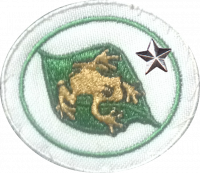AY Honors/Coquí - Advanced/Requirements
1. Have the Coquí honor.
2. Demonstrate slides or photos of five different coquís than those demonstrated in the basic honor, giving the scientific name.
3. Demonstrate slides or photos of two Eleutherodactylus in other countries, besides Puerto Rico.
4. Which are the only coquís that sing or call during the day and why do they do it?
5. Which coquís live in the following habitats:
- a. Floor of the forest.
- b. Under the ground, fallen leaves and roots in the cloud forest of El Yunque National Forest.
- c. High vegetation.
- d. In the grass.
- e. Low vegetation.
- f. Bromeliads.
- g. Caves known as the "guajonales."
- h. In rivers and streams.
- i. In trees.
- j. In the herbaceous wetlands of Sabana Seca (Toa Baja).
6. Of the Puerto Rican coquí, which:
- a. is the only one with webbed feet?
- b. does not lay eggs?
- c. doesn't have a t-shape in its terminal phalanx?
- d. demonstrates sexual dimorphism?
- e. is the only one endemic to El Yunque, Puerto Rico?
- f. is known as the "demon of Puerto Rico?"
- g. has lower reproductive capacity?
7. Among frogs, toads and coquís, the female usually is larger than the male. Among the coquís of Puerto Rico, which male is larger than the female?
8. Among the coquís, who is responsible for the care and incubation of the brood of eggs?
9. What is the lifespan of the coquí?
10. Visit the habitat of at least three species of coquí, and if possible, take a photo of coquí.
11. Choose a coquí species and extract a spiritual lesson, application or illustration, and share it with the club.



